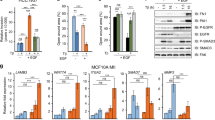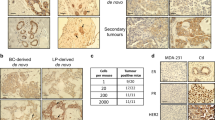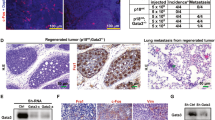Abstract
Activation of the epidermal growth factor receptor (EGFR) family is thought to play an important role in mammary tumorigenesis and metastasis. The potent transforming activity of the EGFR family is due to their ability to heterodimerize with each other in response to a number of mitogenic ligands. The formation of EGFR and ErbB-2 heterodimers has been recently implicated as an important factor in the induction of sporadic human breast cancers. To directly assess whether the catalytic activity of EGFR is required for ErbB-2 induction of mammary tumors, we have interbred transgenic mice expressing ErbB-2 oncogene under the transcriptional control of the mouse mammary tumor virus (MMTV) promoter/enhancer to a naturally occurring mouse mutant carrying a catalytically impaired EGFR (waved-2 mice). Although the female transgenic mice possessing mutant EGFR developed mammary tumors, the tumors occurred only after a delayed latency period, and were fewer in number. The impaired tumor phenotype was further correlated with debilitated phosphorylation of the Gab1 multisubstrate adapter. These observations provide evidence that efficient ErbB-2-induced mammary tumor progression requires EGFR-dependent activation of Gab1.
This is a preview of subscription content, access via your institution
Access options
Subscribe to this journal
Receive 50 print issues and online access
$259.00 per year
only $5.18 per issue
Buy this article
- Purchase on Springer Link
- Instant access to full article PDF
Prices may be subject to local taxes which are calculated during checkout





Similar content being viewed by others
References
Andrulis IL, Bull SB, Blackstein ME, Sutherland D, Mak C, Sidlofsky S, Pritzker KP, Hartwick RW, Hanna W, Lickley L, Wilkinson R, Qizilbash A, Ambus U, Lipa M, Weizel H, Katz A, Baida M, Mariz S, Stoik G, Dacamara P, Strongitharm D, Geddie W and McCready D . (1998). J. Clin. Oncol., 16, 1340–1349.
Fowler KJ, Walker F, Alexander W, Hibbs ML, Nice EC, Bohmer RM, Mann GB, Thumwood C, Maglitto R, Danks JA, Chetty R, Burgess A and Dunn AR . (1995). Proc. Natl. Acad. Sci. USA, 92, 1465–1469.
Goldman R, Levy RB, Peles E and Yarden Y . (1990). Biochemistry, 29, 11024–11028.
Guy CT, Cardiff RD and Muller WJ . (1996). J. Biol. Chem., 271, 7673–7678.
Karunagaran D, Tzahar E, Beerli RR, Chen X, Graus-Porta D, Ratzkin BJ, Seger R, Hynes NE and Yarden Y . (1996). EMBO J., 15, 254–264.
Kraus MH, Issing W, Miki T, Popescu NC and Aaronson SA . (1989). Proc. Natl. Acad. Sci. USA, 86, 9193–9197.
Lenferink AE, Simpson JF, Shawver LK, Coffey RJ, Forbes JT and Arteaga CL . (2000). Proc. Natl. Acad. Sci. USA, 97, 9609–9614.
Luetteke NC, Phillips HK, Qiu TH, Copeland NG, Earp HS, Jenkins NA and Lee DC . (1994). Genes Dev., 8, 399–413.
Matsui Y, Halter SA, Holt JT, Hogan BL and Coffey RJ . (1990). Cell, 61, 1147–1155.
Muller WJ, Arteaga CL, Muthuswamy SK, Siegel PM, Webster MA, Cardiff RD, Meise KS, Li F, Halter SA and Coffey RJ . (1996). Mol. Cell. Biol., 16, 5726–5736.
Muller WJ, Sinn E, Pattengale PK, Wallace R and Leder P . (1988). Cell, 54, 105–115.
Muthuswamy SK, Siegel PM, Dankort DL, Webster MA and Muller WJ . (1994). Mol. Cell. Biol., 14, 735–743.
Plowman GD, Culouscou JM, Whitney GS, Green JM, Carlton GW, Foy L, Neubauer MG and Shoyab M . (1993). Proc. Natl. Acad. Sci. USA, 90, 1746–1750.
Rowse GJ, Ritland SR and Gendler SJ . (1998). Cancer Res., 58, 2675–2679.
Sandgren EP, Luetteke NC, Palmiter RD, Brinster RL and Lee DC . (1990). Cell, 61, 1121–1135.
Sibilia M, Fleischmann A, Behrens A, Stingl L, Carroll J, Watt FM, Schlessinger J and Wagner EF . (2000). Cell, 102, 211–220.
Siegel PM, Ryan ED, Cardiff RD and Muller WJ . (1999). EMBO J., 18, 2149–2164.
Slamon DJ, Clark GM, Wong SG, Levin WJ, Ullrich A and McGuire WL . (1987). Science, 235, 177–182.
Slamon DJ, Godolphin W, Jones LA, Holt JA, Wong SG, Keith DE, Levin WJ, Stuart SG, Udove J, Ullrich A and Press MF . (1989). Science, 244, 707–712.
Sliwkowski MX, Schaefer G, Akita RW, Lofgren JA, Fitzpatrick VD, Nuijens A, Fendly BM, Cerione RA, Vandlen RL and Carraway III KL . (1994). J. Biol. Chem., 269, 14661–14665.
Stern DF and Kamps MP . (1988). EMBO J., 7, 995–1001.
Tzahar E, Waterman H, Chen X, Levkowitz G, Karunagaran D, Lavi S, Ratzkin BJ and Yarden Y . (1996). Mol. Cell. Biol., 16, 5276–5287.
Acknowledgements
We wish to thank Dinsdale Gooden and Alison Gordon for oligonucleotide synthesis, and Brian Allore and Lilie DeSousa for automated DNA sequence analysis (MOBIX Central Facility, McMaster University). We are also grateful to Monica Graham, Carrie Merola and Judy Walls for technical support. This work was supported by grants awarded to WJM by the Canadian Breast Cancer Research Initiative. WJM is a recipient of a CRC Chair in Molecular Oncology award. AS is supported by NSERC PGS-1 award. NS is supported by a scholarship from the United States Army Medical Research Breast Cancer Research Program.
Author information
Authors and Affiliations
Corresponding author
Rights and permissions
About this article
Cite this article
Gillgrass, A., Cardiff, R., Sharan, N. et al. Epidermal growth factor receptor-dependent activation of Gab1 is involved in ErbB-2-mediated mammary tumor progression. Oncogene 22, 9151–9155 (2003). https://doi.org/10.1038/sj.onc.1206983
Received:
Revised:
Accepted:
Published:
Issue Date:
DOI: https://doi.org/10.1038/sj.onc.1206983
Keywords
This article is cited by
-
Dysregulated Gab1 signalling in triple negative breast cancer
Cell Communication and Signaling (2024)
-
Simvastatin induces cell cycle arrest and inhibits proliferation of bladder cancer cells via PPARγ signalling pathway
Scientific Reports (2016)
-
Gab1 regulates SDF-1-induced progression via inhibition of apoptosis pathway induced by PI3K/AKT/Bcl-2/BAX pathway in human chondrosarcoma
Tumor Biology (2016)
-
Gab1 regulates proliferation and migration through the PI3K/Akt signaling pathway in intrahepatic cholangiocarcinoma
Tumor Biology (2015)
-
The ShcA SH2 domain engages a 14-3-3/PI3′K signaling complex and promotes breast cancer cell survival
Oncogene (2012)



